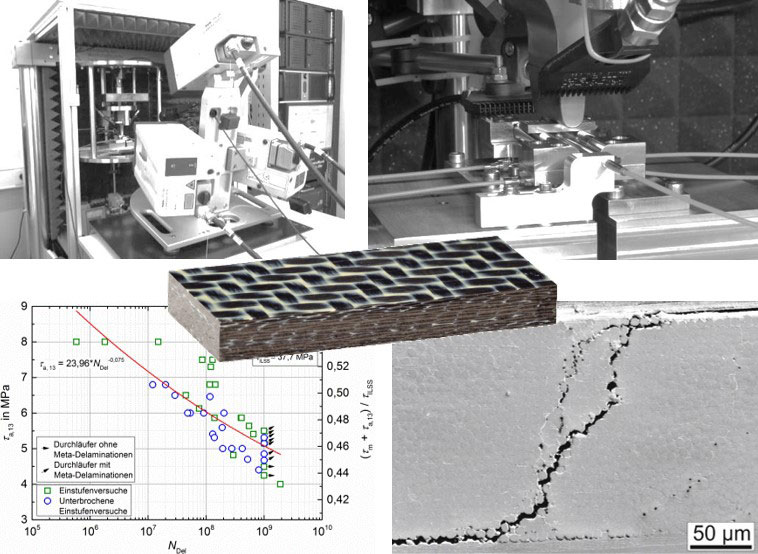Significance Statement
Carbon fiber reinforced polymers (CFRP) are increasingly used for high performance applications, especially for aircraft structures. These structural components are subjected higher than 108 loading cycles during their operation time of more than 20 years.
Dr. Daniel Backe and Prof. Frank Balle from Institute of Materials Science and Engineering (WKK) at University of Kaiserslautern in Germany investigated the ultrasonic fatigue and microstructural damage of carbon fiber fabric reinforced polyphenylene sulfide in their very high cycle fatigue facility. The study appeared in Composites Science and Technology.
The VHCF behavior of a carbon fiber twill 2/2 fabric reinforced polyphenylene sulfide (CF-PPS) was analyzed systematically up to 109 loading cycles. In order to realize these investigations in an economic reasonable time period a novel ultrasonic fatigue testing facility for CFRP was used. Lifetime-oriented investigations at stress ratios showed an exponential decrease of the bearable stress amplitudes in the range between 106 and 109 cycles. Interrupted constant amplitude tests were performed for the characterization of the fatigue damage development. Based on light optical as well as SEM investigations the fatigue damage mechanisms in the VHCF regime were characterized in detail. The surface crack density was determined for several load amplitudes and in different fatigue states by analyzing merged light optical micrographs. Furthermore the stiffness degradation was measured ex-situ during interruptions of the constant amplitude tests, which shows a good correlation with the surface crack density of ultrasonically fatigued CF-PPS.
The study shows an exponential decrease of the bearable shear stress amplitude over the number of cycles to delamination. All described fatigue damages showed a new formation up to specimen failure. So-called meta-delaminations occurred roughly after 70% of the specimens’ lifetime.
The VHCF behavior of a commercial available C-fiber twill 2/2 fabric reinforced polyphenylene sulfide (CF-PPS) was investigated systematically up to a billion loading cycles. To perform the VHCF experiments in an economically reasonable time period a novel ultrasonic fatigue testing facility (f = 20 kHz) for cyclic three point bending was used. To guaranty a maximum increase in temperature of the specimen of DT > 20 °C the entire fatigue experiment was split up in pulse and pause sequences. This leads to an effective test frequency of about 965 Hz and enables fatigue experiments up to a billion cycles in only 12 days for CF-PPS. Due to the geometric boundary conditions shear stress induced fatigue damage was detected for all fatigued CF-PPS specimens. The bearable shear stress amplitudes showed an exponential decrease over the number of cycles to delamination. At least under the applied loading conditions there seems to be no infinite life for the investigated CF-PPS. Nevertheless the fatigue shear strength at 109 cycles could be determined to 4.2 MPa in 13-direction.
Using light optical microscopy the surface crack density was determined for several load amplitudes as well as in different fatigue states. The authors data also showed a characteristic development, a slight increase at the beginning followed by a further increase after nearly 70% of the specimen’s lifetime. The load amplitude seems to have no influence either on the absolute values or on the development of the surface crack density. Both, the surface crack density and the stiffness degradation show a good correlation and a characteristic course as a function of specimen’s lifetime.
Contact details:
Prof. Dr.-Ing. Frank Balle
Hybrid Materials Engineering Group, Institute of Materials Science and Engineering (WKK)
University of Kaiserslautern (Germany)
E-Mail: [email protected]
www.uni-kl.de/WKK

Journal Reference
Daniel Backe, Frank Balle. Ultrasonic fatigue and microstructural characterization of carbon fiber fabric reinforced polyphenylene sulfide in the very high cycle fatigue regime. Composites Science and Technology, Volume 126, 1 April 2016, Pages 115–121.
Institute of Materials Science and Engineering, University of Kaiserslautern, P.O. Box 3049, 67653 Kaiserslautern, Germany.
Go To Composites Science and Technology
 Advances in Engineering Advances in Engineering features breaking research judged by Advances in Engineering advisory team to be of key importance in the Engineering field. Papers are selected from over 10,000 published each week from most peer reviewed journals.
Advances in Engineering Advances in Engineering features breaking research judged by Advances in Engineering advisory team to be of key importance in the Engineering field. Papers are selected from over 10,000 published each week from most peer reviewed journals.

